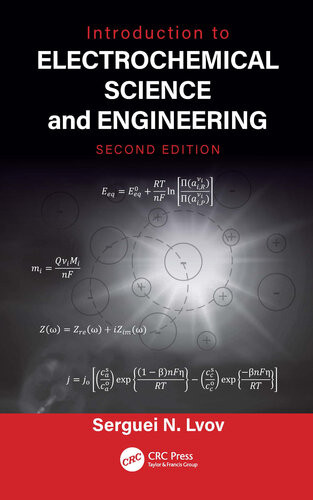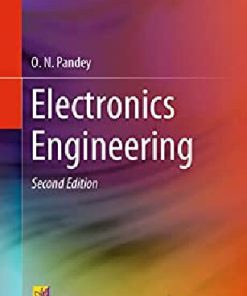Introduction to Electrochemical Science and Engineering 2nd Edition by Serguei Lvov ISBN 1138196789 9781138196780
$50.00 Original price was: $50.00.$25.00Current price is: $25.00.
Introduction to Electrochemical Science and Engineering 2nd Edition by Serguei Lvov – Ebook PDF Instant Download/Delivery: 1138196789 ,9781138196780
Full download Introduction to Electrochemical Science and Engineering 2nd Edition after payment

Product details:
ISBN 10: 1138196789
ISBN 13: 9781138196780
Author: Serguei Lvov
Introduction to Electrochemical Science and Engineering 2nd Edition Table of contents:
Chapter 1 Electrolyte Solutions
1.1 Objectives
1.2 Formation of Electrolyte Solutions
1.3 Electrolyte Concentration and Concentration Scales
1.4 Conversion Equations for the Concentration of Solutions
1.5 Chemical Potential
1.6 Standard Chemical Potential and Activity Coefficient on Different Concentration Scales
1.7 Chemical Potential of Solvent and Solute in Electrolyte Solution
1.8 Activity, Ionic Strength, and Activity Coefficient
1.9 Activity Coefficient of an Electrolyte and an Ion
1.10 Chemical Potential and Gibbs Energy of Formation
1.11 The Debye–Hückel Theory of Dilute Electrolyte Solutions
1.12 Calculation of Activity Coefficient Using the Debye–Hückel Theory
1.13 Calculated and Observed Activity Coefficients
1.14 Mean Activity Coefficient in Concentrated Aqueous Solutions
1.15 Speciation in Weak Electrolytes
1.16 pH of Aqueous Solutions
1.17 pH of Buffer Solutions
1.18 Suggested pH of Standard Solutions
1.19 Summary
1.20 Exercises
References
Chapter 2 Electrochemical Cells
2.1 Objectives
2.2 Basic and Derived SI Units
2.3 Electrochemical Cell (System)
2.4 Electrolytic and Galvanic Cells
2.5 Electrochemical Diagrams (Traditional)
2.6 New Electrochemical Diagrams
2.7 Faraday’s Law of Electrolysis
2.8 Fundamental Constants
2.9 Water Electrolysis
2.10 Ohm’s Law
2.11 Kirchhoff’s Law
2.12 Electrochemical Cells with Transfer
2.13 Daniell Cell in Galvanic Mode
2.14 Daniell Cell in Electrolytic Mode
2.15 Cell Potential-Current Dependence
2.16 Summary
2.17 Exercises
References
Chapter 3 Electric Conductivity
3.1 Objectives
3.2 Types of Electric Conductivity
3.3 Significance of Ion Conductive Materials for Electrochemical Engineering
3.4 Origin of Ionic Conductivity
3.5 Conductance and Conductivity of an Electrolyte
3.6 Electric Conductivity of Pure Water
3.7 Conductance by Direct and Alternating Currents
3.8 Electrode/Electrolyte Interface
3.9 Extracting the Electrolyte Resistance
3.10 Conductivity Measurements
3.11 Molar and Equivalent Conductivity
3.12 Kohlrausch’s Law and Limiting Conductivity
3.13 Additivity of Electrolyte Limiting Conductivity
3.14 Transport Numbers
3.15 Diffusion and Hydration of Ions in Infinitely Diluted Solution
3.16 Proton Conductivity
3.17 Walden’s Rule
3.18 Summary
3.19 Exercises
References
Chapter 4 Equilibrium Electrochemistry
4.1 Objectives
4.2 Equilibrium Thermodynamics and Electrochemistry
4.3 Equilibrium between Phases in an Electrochemical Cell
4.4 Galvani Potential of the Hydrogen Electrode
4.5 Gibbs Energy of Reaction and Equilibrium Electrode Potential
4.6 Nernst Equation
4.7 Standard Hydrogen Electrode (SHE)
4.8 Ag/AgCl Reference Electrode
4.9 Harned Cell
4.10 Electrochemical Series
4.11 Calculation of Equilibrium Potential of the Daniell Cell
4.12 Nernst Equations for Typical Electrodes
4.13 Another Example of Estimating of E0 and E
4.14 Calculation of E0 at Elevated Temperature
4.15 Temperature Dependence of the Standard Electrode Potential
4.16 Temperature Dependence of Open Circuit and Decomposition Potentials
4.17 Potential–pH (Pourbaix) Diagram
4.18 Summary
4.19 Exercises
References
Chapter 5 Electrochemical Techniques I
5.1 Objectives
5.2 Potentiometric Measurements
5.3 Commercial Ag/AgCl Reference Electrode
5.4 Commercial Calomel Reference Electrode
5.5 pH Glass Electrode
5.6 Liquid Junction (Diffusion) Potential
5.7 Henderson Equation
5.8 Calculation of the Diffusion Potential
5.9 Minimization of the Diffusion Potential in a Cell
5.10 Kinds of Potentiometry
5.11 Measurement of the Standard Electrode Potential
5.12 Measurement of pH
5.13 Combined pH/Reference Electrode Sensor and pH Meter
5.14 Summary
5.15 Exercises
References
Chapter 6 Electrochemical Kinetics
6.1 Objectives
6.2 Concept of Electrochemical Cell Overpotential
6.3 Overpotential of a Single Electrode
6.4 Polarization Curve of a Single Electrode
6.5 Mechanism of Electrochemical Reaction
6.6 Charge Transfer Overpotential: Butler–Volmer Equation
6.7 Symmetry Factor, β
6.8 Exchange Current Density, jo
6.9 Experimental Data on the Exchange Current Density and Symmetry Coefficient
6.10 Simplifications of the Butler–Volmer Equation
6.11 Tafel Equation
6.12 Volcano Plot
6.13 Concentration Overpotential
6.14 Mass Transfer Overpotential
6.15 Generalized Butler–Volmer Equation
6.16 Summary
6.17 Exercises
References
Chapter 7 Electrochemical Techniques II
7.1 Objectives
7.2 Transport Processes in Electrochemical Systems
7.3 Current–Time Dependence at Constant Potential (Potentiostatic Regime)
7.4 Concentration–Time Dependence at Constant Current (Galvanostatic Regime)
7.5 Effect of Hydrodynamics (Fluid Mechanics) on Electrochemical Reaction
7.6 Rotating Disk Electrode and Limiting Current
7.7 Rotating Disk Electrode Electrochemical Cell
7.8 Cyclic Voltammetry Background
7.9 Cyclic Voltammetry of Fe(CN)63−/Fe(CN)64− Couple
7.10 Electrochemical Impedance Spectroscopy
7.10.1 Complex Variables
7.10.2 Response of Current to Applied Oscillating Potential
7.10.3 Impedance of Circuit Components
7.10.4 Impedance of the Randles Circuit
7.10.5 Nyquist Plot
7.10.6 Bode Plot
7.10.7 Warburg Impedance
7.11 Summary
7.12 Exercises
References
Chapter 8 Electrochemical Energy Conversion
8.1 Objectives
8.2 Main Types of Electrochemical Energy Conversion Systems
8.3 Principal Design of a Fuel Cell
8.4 Main Kinds of Fuel Cells
8.5 Electrochemistry of Fuel Cells
8.6 Three-Phase Boundary Issue
8.7 New Electrochemical Diagrams for Fuel Cells
8.8 Polarization Curves of PEMFC and SOFC
8.9 Efficiency of Fuel Cell versus Heat Engine
8.10 Total Efficiency of Fuel and Electrolytic Cells
8.11 Heat Balance in Fuel and Electrolytic Cells
8.12 Summary
8.13 Exercises
References
Chapter 9 Electrochemical Corrosion
9.1 Objectives
9.2 Origin of Electrochemical Corrosion
9.3 Pourbaix Diagram in Corrosion Science
9.4 Polarization Curve of Metal Corrosion
9.5 Corrosion Potential and Current Density
9.6 Rate of Electrochemical Corrosion
9.7 Corrosion Protection
9.8 Kinds of Corrosion
9.9 Summary
9.10 Exercises
References
Chapter 10 Data Section
10.1 CODATA Values of the Fundamental Physical Constants
10.2 Physical Constants of Inorganic Compounds
10.3 Standard Thermodynamic Properties of Chemical Substances
10.4 Thermodynamic Properties as a Function of Temperature
10.5 Thermodynamic Properties of Aqueous Ions
10.6 Ionization Constant of Water as a Function of Temperature and Pressure
10.7 Electric Conductivity of Water
10.8 Electric Conductivity of Aqueous Solutions
10.9 Standard KCl Solutions for Calibrating Conductivity Cells
10.10 Molar Conductivity of Aqueous HCl
10.11 Molar Conductivity of Electrolytes
10.12 Ionic Conductivity and Diffusion Coefficient at Infinite Dilution
10.13 Electrochemical Series
10.14 Dissociation Constants of Inorganic Acids and Bases
10.15 Dissociation Constants of Organic Acids and Bases
10.16 Activity Coefficients of Aqueous Acids, Bases, and Salts
10.17 Mean Activity Coefficients of Aqueous Electrolytes
10.18 Concentrative Properties of Aqueous Solutions
10.19 Aqueous Solubility of Inorganic Compounds at Various Temperatures
10.20 Solubility Product Constants
10.21 Solubility of Common Salts at Ambient Temperatures
10.22 Thermophysical Properties of Water and Steam at Temperatures up to 100°C
10.23 Vapor Pressure and Other Saturation Properties of Water at Temperatures up to 100°C (373.15 K)
10.24 van der Waals Constants for Gases
10.25 Vapor Pressure of Saturated Salt Solutions
10.26 Electric Resistivity of Pure Metals
10.27 Composition of Seawater and Ionic Strength on Molality Scale at Various Salinities S in Parts per Thousand
10.28 Error Function
10.29 Periodic Table of Elements
Appendix A: Quizzes
Appendix B: Video-Based Assignments
Appendix C: Laboratory Instructions
Index
People also search for Introduction to Electrochemical Science and Engineering 2nd Edition:
an electrochemical cell example
6.01 electrochemical processes
four main types of electrochemical cells
introduction to science 4th grade
introduction to electrochemistry tyler dewitt
Tags: Serguei Lvov, Electrochemical Science, Engineering
You may also like…
Relationships & Lifestyle - Diet & Nutrition
Reference - Library & Information Science
Introduction to Information Science 2nd Edition David Bawden Lyn Robinson
Uncategorized
INTRODUCTION TO MATERIALS SCIENCE AND ENGINEERING. 2nd Edition Yip-Wah Kapoor Monica Chung
Engineering - Chemical Engineering
Introduction to Chemical Engineering Thermodynamics 2nd Edition by Gopinath Halder 9788120348974
Engineering - Electrical & Electronic Engineering
Computers - Information Systems
Introduction to Information Science 2nd Edition David Bawden











